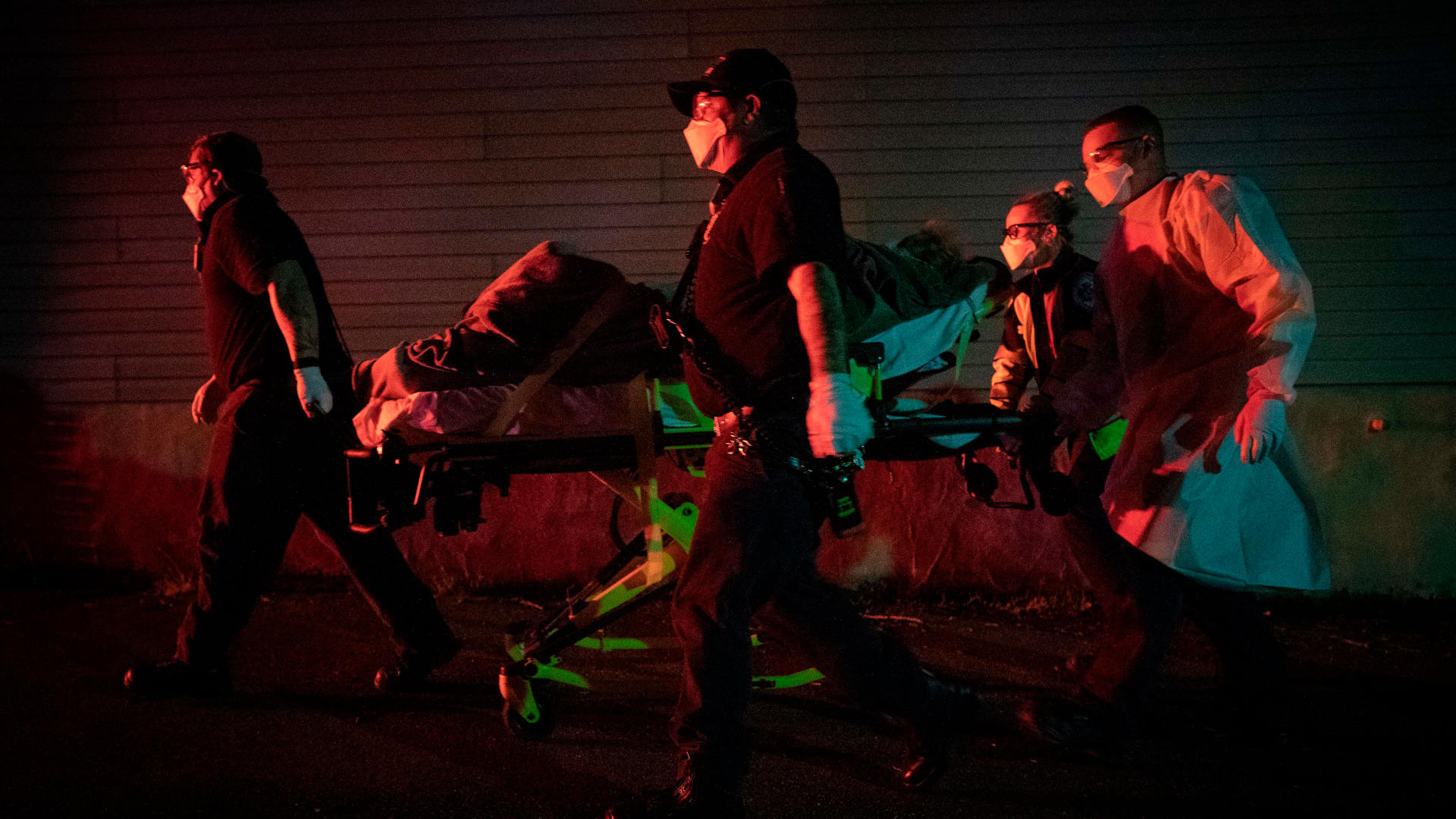When President Biden said last fall that “the pandemic is over,” some people applauded what they saw as an honest appraisal, while others pointed out that hundreds of people were dying from Covid-19 every day in the United States. Americans are still dying from Covid-19. And yet life now resembles the pre-Covid times more than at any point since the start of the pandemic. Restaurants are crowded. Masks are scarce. Vaccines and medications have proven safe and effective. The World Health Organization has determined that Covid is no longer a public health emergency.
What seems clear is that we have crossed a threshold: The acute, collective crisis of the first years of the pandemic has ebbed. Now may be a moment to look back on what we’ve just been through, and try to make some sense of it.
What have we just been through? The dislocation and destruction wrought by the pandemic have touched every aspect of life, everywhere. Millions of people died. Millions more lost their loved ones, their livelihoods, their health. All of us endured years of isolation, fear, and uncertainty. At the emergency room where I work, I saw patients younger than me succumb to the virus. I saw patients die for lack of a hospital bed or ventilator.
The impact of the pandemic seems almost too vast to be reckoned with. But some experts suggest that the essence and consequences of what we’ve endured can be captured with a single concept: trauma.
“The scale of this outbreak as a traumatic event is almost beyond comprehension,” Yuval Neria, a professor of psychology at Columbia University, told CNBC in 2020. That same year, researchers writing in Nature Human Behavior described the pandemic as part of a cascade of collective traumas, and psychologists from New York University argued that the Covid-19 pandemic “can and should be viewed from the perspective of trauma.”
Were we all, to some degree, traumatized by the pandemic? If so, can an understanding of trauma suggest a path toward healing?
To decide whether the pandemic was a collective trauma, we should first define trauma. In its original Greek usage, trauma was physical — a wound to the body. The idea of psychological trauma, whereby experience alone could produce durable harm to the mind, wasn’t proposed until the 1850s, when a French physician argued that adverse experiences in childhood were associated with mental illness. In 1889, psychologist Pierre Janet described a consistent triad of symptoms that occurred after traumatic experiences: dissociation, reexperiencing, and hyperarousal — similar to the symptoms we now recognize as post-traumatic stress disorder. Trauma, he thought, resulted from an inability to integrate the experience into our narrative of ourselves, to give it meaning.
When PTSD entered the lexicon of psychiatry in the 1980s, the field had moved away from the conceptual world of Janet. A new biological materialism, focused more on the brain than on the mind, was ascendant. Researchers hunted for physical or structural abnormalities in the brain that might explain the disorder, and perhaps lead to a drug that could treat it. But their efforts didn’t produce a pharmaceutical cure. Although a number of drugs are prescribed to treat PTSD, their efficacy is limited.
As researchers continued investigating trauma, more questions emerged. For instance: What constitutes a traumatic event? In 1980, the Diagnostic and Statistical Manual of Mental Disorders, or DSM, a guiding text for psychiatric practice, defined it as anything evoking “significant symptoms of distress in almost everyone.” In 1994, this definition was revised to be more specific and objective: Traumatic events threatened death or serious injury, causing intense fear or helplessness. In 2013, the DSM definition was amended to include sexual violence alongside death and injury, and to allow that PTSD could result from simply learning about such an event.
The DSM appeared to be wrestling with two opposing forces. On the one hand, it seemed important to exclude minor adversity from definitions of trauma, lest common tribulations be pathologized. But on the other, there was recognition that post-traumatic symptoms did sometimes occur following a broader, more protean spectrum of exposures.
Some evidence suggests that the spectrum of symptoms may also be broader than those defined in the DSM. In the 1990s, a physician named Vincent Felitti partnered with the Centers for Disease Control and Prevention to undertake the Adverse Childhood Experiences Study, which surveyed 17,421 adult patients and tracked their health over time. The results were startling. Each patient was asked about eight categories of childhood adversity — physical abuse, for instance, or parental divorce. Only a third reported that they’d had no adverse experiences as children. People who had been exposed to four or more categories of adversity were seven times more likely than those with no exposure to develop alcoholism. Those who had been exposed to six or more categories were two times more likely to develop cancer, four times more likely to develop emphysema, 46 times more likely to use IV drugs, and 51 times more likely to attempt suicide than those who hadn’t suffered adverse experiences. In his 2015 book “The Body Keeps the Score: Brain, Mind, and Body in the Healing of Trauma,” psychiatrist Bessel van der Kolk cites Felitti in saying that practitioners “may be treating today experiences that happened fifty years ago.”
Paul Conti, a psychiatrist and author of “Trauma: The Invisible Epidemic,” told me that from his perspective, the definition of trauma can be simple: “We can just ask the question,” Conti said, “is this person different after something traumatic?”
Are we ourselves different, after having endured a global pandemic? Of course we are. In the E.R. these past three years, I’ve seen more substance abuse, more domestic violence, more anxiety. Painful things change us, sometimes in normal and healthy ways. “Such are the raw materials of life,” writes David J. Morris in “The Evil Hours: A Biography of Post-traumatic Stress Disorder.” “We are our scars.”
But is this trauma?
In his book “The Trouble with Trauma,” Tulane University psychiatrist Michael Scheeringa argues that such a formulation of trauma is so pliant as to allow almost any experience to be deemed traumatic. He worries that applying the lens of trauma indiscriminately serves only to pathologize normal experiences.
Is Scheeringa right? And if we believe he is, could we be enduring not trauma but just the difficult human consequences of a global cataclysm? Is there a difference?
Part of the reason trauma remains such a mystery may be because the concept doesn’t fit our usual models of disease. Medicine favors objectivity. (Does the scan show pneumonia or not?) But we can’t actually touch the stuff of mental illness. Advanced brain imaging and other technologies may further our understanding of trauma, but they have so far not furnished all secrets. The truth seems to be that trauma is inescapably subjective, and medicine struggles with this.
In 2018, researchers discovered something surprising. They compared rates of PTSD across 24 countries against an index of vulnerability to traumatic events. They expected to find that more vulnerable countries would have higher rates of PTSD, but instead they found the opposite: Countries with higher vulnerability had less PTSD. Some have criticized their methods, but the authors stand by them. Although they note their study has limitations, they hypothesize that PTSD may be a product not just of a life-threatening event itself, but of the degree to which it collides with our expectations. In other words, trauma is the product not only of our subjective experience of an event, but of its interplay with our understanding of the world itself, and of our place in it. Every trauma, then, may be perfectly unique — a product of the infinite variegation of each individual, their worldview, the context of their life, and the traumatic circumstance itself. How could we ever hope to standardize and codify such a multifaceted, multiplicitous thing?
Perhaps what we now need most, as the exigency of the pandemic ebbs and many of us reach for normalcy, is an understanding of how to integrate this experience into the narrative of ourselves, as Janet argued more than a century ago. Judith L. Herman, a prominent trauma researcher, has written that a trauma survivor “must be the author and arbiter of her own recovery.” How will we author our collective and individual recoveries from the calamity of the pandemic? Can we be better from it? Will we recognize and begin to rectify the structural inequities which the virus so effectively exploited? Will we see the importance of collective, concerted action against truly global problems?
I’m sympathetic to the idea that traumatic experience can cause real, persistent harm, in elusive and enigmatic ways. I recognize that a world of traumatic dark matter exists out there, the extent of which I can never fully know, exerting its gravity on the lives of my patients.
I suspect that I will never be able to definitively diagnose who among my patients has been traumatized, and who has not. I have no scan, no test, to guide me. But knowing that I cannot know creates space for humility, and empathy. Instead of dispensing a diagnosis, I might be better off asking them: What has the pandemic meant to you?
Clayton Dalton is a writer in New Mexico, where he works as an emergency physician.












Comments are automatically closed one year after article publication. Archived comments are below.
I say this with the utmost concern. This article reads like semantic soup with glaring internalized mental health stigmatization that hurts yourself and many other people seeking understanding. Pandemics, civil unrest, 9/11, mass shootings are not “normal experiences”. Humans should not have constant assaults on their psyche. Graphic media reports impact on society needs to be studied because there is a growing number of reports on disassociation disorders mainly from a generation that was raised on television. Seeing something on TV may just be as traumatizing as being there in person.
Based on your entire article, it makes me concerned that you will be evidently gaslighting your future patients. Having a globalized shutdown was unusual and disconcerting. Nothing made sense and full out city battles were emerging all over the world, especially for those that have not recovered from the widescale graphic reporting of 9/11 and mass shootings.
Trauma only started when politics got involved.